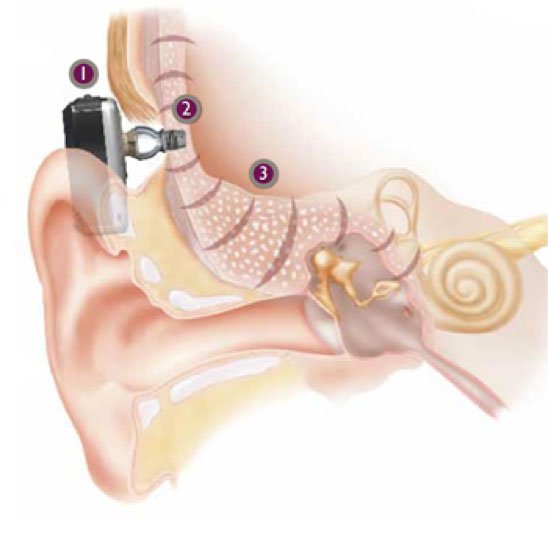Bone-Anchored Hearing Aid (BAHA)
In cases where the middle ear function is blocked, damaged or occluded, the Baha System may be a better option as it bypasses the outer and middle ear altogether. Instead, sound is sent around the damaged or problematic area, naturally stimulating the cochlea through bone conduction.
When someone has lost most of the hearing in one ear, but has normal hearing on the other side, the Baha System works to reroute sound to the better ear. It uses our body’s natural ability to conduct sound through bone to deliver the signal to the better hearing ear.
Once the cochlea receives these sound vibrations, the organ ‘hears’ in the same manner as through air conduction. The sound is converted into neural signals and is transferred to the brain, allowing a Baha recipient to perceive sound.
We hear sound in two different ways―air conduction and bone conduction. Air conduction hearing is when sound waves travel from the outer ear, through the middle ear to the inner ear. In contrast, bone conduction hearing is when sound vibrations travel directly to the inner ear through the skull bone. In cases where there is damage to the outer or middle ear, or when one of these parts does not function, an air conduction hearing pathway cannot reach the inner ear. Instead of trying to push sound through the damaged area, as is done with hearing aids, direct bone conduction systems send it directly through the bone, naturally stimulating the inner ear. Most hearing healthcare professionals agree that direct bone conduction systems are a more effective solution for patients with mixed hearing loss, conductive hearing loss or single-sided deafness.
How does a Bone-Anchored Hearing Aid (BAHA) work?
- Sound waves are received by the Cochlear Baha Sound Processor and changed into vibrations.
- Vibrations from the sound processor are transferred from the abutment to the titanium implant.
- The implant uses direct bone conduction to transfer the sound vibrations to the functioning cochlea.
In adults, surgery is often performed as an outpatient procedure under local anesthesia. The bone behind the ear is exposed through a straight incision or with the help of a specially designed dermatome. A hole, 3 or 4 mm deep depending on the thickness of the bone, is drilled. The hole is widened and the implant with the pre-mounted coupling is inserted under generous cooling to minimize the surgical trauma to the bone.
Most surgeons perform a reduction of the subcutaneous soft tissue. The rationale for this is to reduce the mobility between the implant and skin to avoid inflammation at the penetration site. This reduction of the soft tissue has been questioned and some surgeons only perform a minimum of soft tissue work. Six to twelve weeks later the audiologist will fit and adjust the hearing processor according to the patient’s hearing level.

